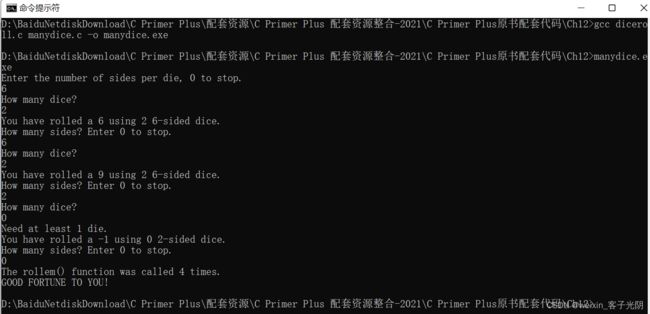- python --桌面开发pyqt安装(mac 环境)
Xiao_Qiang_
python
纪录下,在安装pyqt的时候花了些时间,现在纪录下参考http://www.noktec.be/python/how-to-install-pyqt4-on-osx步骤DownloadtheSIPpackage(snapshotforOSx)DownloadthePyQtpackage(snapshotforOSx)DownloadQtInstallQtInstallSIPInstallPyQta
- 【004安卓开发方案调研】之Ionic+Vue+Capacitor开发安卓
ThinkPet
移动app开发androidionicCapacitorVue
基于Ionic+Vue+CapacitorPlugins的国内安卓开发生态和技术现状,结合跨平台框架特性与国内实际环境,以下是综合分析:一、技术成熟度评估1.核心优势跨平台开发效率Ionic提供预制的UI组件库(如卡片、列表、表单),结合Vue的响应式数据绑定,可快速构建80%以上的基础功能界面,开发效率比原生开发提升约40%。典型场景:企业内部工具App、电商商品详情页、新闻资讯类应用。Capa
- Oracle证书靠谱吗?值得考吗?
噗老师
Oracle认证oracle数据库
Oracle认证在数据库管理领域享有极高的声誉和价值,是许多专业人士职业生涯中的重要里程碑。那么,Oracle认证是否值得投入时间和精力去考取呢?这个问题的答案很大程度上取决于你的职业规划、个人兴趣和对未来的展望。首先,Oracle认证的价值还体现在其广泛的行业需求上。在金融、医疗、政府等多个行业中,对数据库管理和分析的依赖性日益增加,这导致了对Oracle专业人才的巨大需求。Oracle数据库在
- 基础实验3-2.4 出栈序列的合法性(栈和队列的运用c语言)
Feliz..
数据结构数据结构
题目:给定一个最大容量为m的堆栈,将n个数字按1,2,3,...,n的顺序入栈,允许按任何顺序出栈,则哪些数字序列是不可能得到的?例如给定m=5、n=7,则我们有可能得到{1,2,3,4,5,6,7},但不可能得到{3,2,1,7,5,6,4}。输入格式:输入第一行给出3个不超过1000的正整数:m(堆栈最大容量)、n(入栈元素个数)、k(待检查的出栈序列个数)。最后k行,每行给出n个数字的出栈序
- 深入理解Python闭包与递归:原理、应用与实践
Multiple-ji
python开发语言
目录闭包什么是闭包:闭包的基本结构:实现闭包的条件:1.嵌套函数2.内函数引用外部函数的变量3.外部函数返回内部函数4.外部函数已经执行完毕递归函数什么是递归函数:递归函数条件1.必须有个明确的结束条件———递归出口2.每进行更深一步的递归,问题规模相比上一次递归都要有所减少3.相邻两次重复之间有紧密联系分析一下这段代码1.函数定义:2.基准条件(BaseCase)3.递归条件(Recursive
- Oracle OCP认证是否值得考?
博睿谷IT99_
数据库oracle开闭原则数据库
OracleOCP(OracleCertifiedProfessional)认证是数据库领域的传统权威认证,但随着云数据库和开源技术的崛起,其价值正面临分化。是否值得考取,需结合你的职业定位、行业需求及长期规划综合判断。以下是关键分析:一、什么情况下值得考?1.职业定位明确:扎根传统数据库领域适用人群:从事金融、电信、能源等传统行业的DBA(数据库管理员);需维护Oracle旧版本(如11g/12
- Golang可选参数实践
yzh_1346983557
golang可选参数
背景:go不支持类似java的方法重载,但对于函数的可选参数和默认参数配置,通常要在不影响不破坏现有逻辑基础上进行参数的添加。实现:通过options选项,使用函数进行参数的初始化和可选值的设置。代码:packagemainimport"fmt"//go实现可选参数实践//背景:go不支持方法重载,但对于函数的可选参数和默认参数配置,通常要在不影响不破坏现有逻辑基础上进行参数的添加//实现:通过o
- linux系统安全加固
xiejin007
linux运维linux运维
linux系统安全加固linux系统安全加固linux系统安全加固脚本系统加固脚本下载地址:https://download.csdn.net/download/hzgnet2021/63201374时间获取脚本开头先获取本机时间#Variablerq=`date+%Y%m%d`Linux禁用不使用的用户将passwd先复制一份备份,然后将以下不使用的用户都禁用,如后期有需要恢复可使用passwd
- 强化学习中策略网络模型设计与优化技巧
数字扫地僧
计算机视觉深度学习
I.引言强化学习(ReinforcementLearning,RL)是一种通过与环境交互,学习如何采取行动以最大化累积奖励的机器学习方法。策略网络(PolicyNetwork)是强化学习中一种重要的模型,它直接输出动作的概率分布或具体的动作。本篇博客将深入探讨策略网络的设计原则、优化技巧,并结合具体实例展示其应用。II.策略网络的基本概念A.策略网络的定义策略网络是一种神经网络,它接受当前状态作为
- 微服务SpringCloud配置Gateway网关
weixin_46088323
springcloud微服务gateway
微服务SpringCloud配置Gateway网关1.新建Modulecloud-gateway-gateway95272.pom文件添加修改org.springframework.cloudspring-cloud-starter-gatewayorg.springframework.cloudspring-cloud-starter-netflix-eureka-client3.yml文件配置
- 知识图谱系列文章——文物知识图谱
weixin_43407382
知识图谱
文章介绍背景1、文物可以提供创意,如哥窑面饰的照相机2、目前文物数字化工作非常少,没有纳入设计元素3、文物知识图谱建成后具有很多好处&#¥方法一、本体构建1、明确领域和目的——文物知识图谱&设计创意2、领域信息采集与分析——文物信息,340件文物实例,3、定义文物本体概念和结构层次4、定义概念属性和属性约束5、本体编码(建模语言和工具)6、本体评估——Jena的内嵌推理机,基于描述的逻辑7、本体实
- Ubuntu新服务器安装流程整理
Sion木子
Linux服务器ubuntulinux1024程序员节
Ubuntu新服务器安装流程整理1、修改计算机名2、设置时区与时间3、修改DNS4、更新软件包列表,升级软件包5、清理不再需要的软件包6、清理缓存7、更换内核8、设置SSH空闲超时时间9、设置SSH密码最小间隔天数10、配置GRUB引导加载程序文件权限11、处理具有SUID和SGID权限的文件以防止潜在的权限提升风险12、限制核心转储(coredumps)、禁Ping、开启TCP-SYNcooki
- 自动化配置管理工具 SaltStack-03
Mr.Ron
linux自动化服务器运维
一、Jinja模板应用案例1、需求描述给之前通过saltstack安装好的lamp环境的apache修改配置文件,要求每个主机监听自己ip的80端口。2、实现思路如果通过单纯的修改配置文件根本无法实现,所以我们需要用到模板,将配置文件作为模板,通过定义模板中的变量来实现,并且需要引用grians参数。#编辑state配置文件[root@server~]#vim/srv/salt/prod/apac
- Linux进程间通信:消息队列与msgget函数使用详解
无形小手
本文还有配套的精品资源,点击获取简介:本文深入介绍了Linux消息队列的创建和操作方法,包括msgget()、msgsnd()和msgrcv()三个核心函数。介绍了通过消息队列实现进程间通信的基础实验步骤和关键要点,如键值计算、消息发送和接收,以及进程间通信时常见的权限控制、消息顺序、类型匹配和同步问题。通过学习这些内容,开发者能够更好地理解和掌握如何在项目中实现高效的进程间通信。1.Linux消
- 麒麟服务器操作系统Redis部署手册
太极淘
麒麟操作系统管理工具服务器redis运维
软件简介Redis****介绍REmoteDIctionaryServer(Redis)是一个由SalvatoreSanfilippo写的key-value存储系统,是跨平台的非关系型数据库。Redis是一个开源的使用ANSIC语言编写、遵守BSD协议、支持网络、可基于内存、分布式、可选持久性的键值对(Key-Value)存储数据库,并提供多种语言的API。Redis通常被称为数据结构服务器,因为
- JavaScript常用函数测试demo
sunny05296
JavaScriptjavascript开发语言ecmascript
JavaScript常用函数测试demovimJavaScriptTestDemo.html内容如下:JavaScriptfunctionstestdemoEnterF12toviewtheconsoleoutputmessageofconsole.log()EnterF5torefresh//JavaScriptint2string/string2inttestfunctiontest01(){
- 达梦主备集群部署
sunny05296
数据库数据库达梦
DM数据守护(DataWatch)介绍DM数据守护(DataWatch)是一种集成化的高可用、高性能数据库解决方案,是数据库异地容灾的首选方案。达梦数据守护可快速恢复服务,只需数秒时间就可以将备库切换为主库对外提供数据库服务。DM数据守护提供多种解决方案,可以配置成实时主备、MPP主备、DMDSC主备或读写分离集群。实时主备由一个主库以及一个或者多个配置了实时(Realtime)归档的备库组成,其
- 麒麟服务器操作系统PostgreSQL环境部署手册
太极淘
麒麟操作系统管理工具linux服务器
软件简介PostgreSQL是一个免费的对象-关系数据库服务器(ORDBMS),在灵活的BSD许可证下发行。ORDBMS(对象关系数据库系统)是面向对象技术与传统的关系数据库相结合的产物,查询处理是ORDBMS的重要组成部分,它的性能优劣将直接影响到DBMS的性能。软件环境操作系统环境操作系统版本操作系统架构银河麒麟服务器操作系统V10SP系列X86-64银河麒麟服务器操作系统V10SP系列ARM
- Ubuntu arm64 安装docker
sglin123
docker容器运维
通过docker官方链接安装,如果无法链接,需要通过或者链接外网,国内如果屏蔽1.卸载旧版本Ubuntu自带的Docker版本太低,需要先卸载旧的再安装新的。sudoapt-getremovedockerdocker-enginedocker.iocontainerdrunc2.更新软件包列表和已安装软件的版本sudoaptupdatesudoaptupgrade3.安装必要的证书并允许apt包管
- Linux系统安全防护加固
寰宇001
Ubuntucentos
账号和口令1.1删除系统不需要的默认账号操作步骤使用命令userdel删除不必要的账号。使用命令passwd-l锁定不必要的账号。使用命令passwd-u解锁必要的账号。#userdellp#groupdellp#passwd–llp如果下面这些系统默认帐号不需要的话,建议删除。lp,syncnews,uucp,games,bin、man修改一些系统帐号的shell变量,例如uucp,ftp和ne
- C++和标准库速成(十一)——简单雇员系统
梦醒沉醉
C++20c++
目录1.雇员记录系统2.Employee类2.1Employee模块接口文件2.1.1实现细节2.1.2完整代码2.2Employ模块实现文件2.2.1实现细节2.2.2完整代码2.3Employee测试文件3.Database类3.1Database模块接口文件3.1.1实现细节3.1.2完整代码3.2Database模块实现文件3.2.1实现细节3.2.2完整代码3.3Database测试文件
- Linux系统安全加固基础
linux言叙
Linux安全系统加固linuxcentos运维
注:建议在修改相关配置文件时,首先对需要修改文件进行备份。1、ssh远程连接vi/etc/sshd/sshd_configPort65531#修改ssh端口,默认22ListenAddress192.168.1.X#允许ssh登录的IP地址PermitRootLoginno#禁止root通过ssh连接)
[email protected].*#允许用户test从IP为192.168.1
- 【go】从函数输入选择思考到关注点分离原则
还没入门的大菜狗
golang开发语言
在阅读《100个go语言经典错误》的时候,看到错误:使用文件名作为函数输入。由此思考,这个虽然是入参的设计,但是实际上涉及到了函数的抽象问题。从函数输入选择与函数抽象的最佳实践到思考关注点分离原则。函数输入选择与函数抽象的最佳实践通过分析46-function-input中的代码,我们可以总结出关于函数输入选择的重要原则以及函数抽象的深入思考。一、函数名不应包含输入来源代码展示了两个功能相似但设计
- 【go】Go中错误包装的最佳实践与常见误区
还没入门的大菜狗
golang
Go中错误包装的最佳实践与常见误区通过分析100-go-mistakes-master/src/07-error-management/49-error-wrapping/main.go中的代码,我们可以总结有关错误包装的典型错误、最佳实践和选择准则。一、错误包装的基本概念错误包装是指在处理错误时,将原始错误封装在新的错误中,同时添加上下文信息。代码示例展示了四种不同的错误处理方式,每种都有不同的
- 【go语言规范】 使用函数式选项 Functional Options 模式处理可选配置
还没入门的大菜狗
golang开发语言后端
如何处理可选配置?ConfigStruct方式(config-struct/main.go)这是最简单的方式,使用一个配置结构体:定义了一个简单的Config结构体,包含Port字段创建服务器时直接传入配置对象优点:简单直接缺点:不够灵活,所有字段都必须设置值,即使只想修改其中一个Builder模式(builder/main.go)使用建造者模式:定义ConfigBuilder结构体来构建配置提供
- 在华为鲲鹏服务器银河麒麟V10操作系统中安装docker及docker-pose
qinfeng1991
服务器dockereureka
背景最近客户寄来几台为鲲鹏服务器,需要在上面安装docker及docker-compose以便运行我们的程序,跟常规的X86架构下安装docker和docker-compose稍微有些区别,特此记录。操作步骤0.系统版本查看[root@localhostcrcs-compile]#cat/etc/kylin-releaseKylinLinuxAdvancedServerreleaseV10(Lan
- 查询、插入、更新、删除数据的SQL语句(SQLite)
C++ 老炮儿的技术栈
sqlc++算法笔记学习
以下以SQLite数据库为例,展示在C++中使用SQLite库来执行查询、插入、更新和删除数据的操作示例代码。首先确保你已经安装了SQLite库,并且在C++项目中包含了相关的头文件。#include#include#include//回调函数,用于查询结果处理staticintcallback(void*NotUsed,intargc,char**argv,char**azColName){fo
- 异步编程与流水线架构:从理论到高并发
长安er
学习心得高性能并行计算光电架构数学建模GUI全息异步多线程流水线
目录一、异步编程核心机制解析1.1同步与异步的本质区别1.1.1控制流模型1.1.2资源利用对比1.2阻塞与非阻塞的技术实现1.2.1阻塞I/O模型1.2.2非阻塞I/O模型1.3异步编程关键技术1.3.1事件循环机制1.3.2Future/Promise模式1.3.3协程(Coroutine)1.4同步与异步的混合编程1.4.1同步转异步模式1.4.2异步转同步模式二、全息成像流水线中的异步实践
- C++:类(通识版)
愚戏师
C++c++开发语言数据结构算法
类的基本思想是数据抽象(dataabstraction)和封装(encapsulation)。数据抽象是一种依赖于接口(interface)和实现(implementation)分离的编程(以及设计)技术。类的接口包括用户所能执行的操作;类的实现则包括类的数据成员、负责接口实现的函数体以及定义类所需的各种私有函数。封装实现了类的接口和实现的分离。封装后的类隐藏了它的实现细节,也就是说,类的用户只能
- pip设置国内源 pip设置国内镜像
程序员leon
Linux系列pippython
以下是配置pip国内镜像源的完整方法及注意事项,综合主流配置方案和常见问题解决方案:一、临时使用国内源(单次有效)安装时通过-i参数指定镜像源:pipinstall包名-ihttps://pypi.tuna.tsinghua.edu.cn/simple--trusted-hostpypi.tuna.tsinghua.edu.cn-推荐源地址*:清华大学:https://pypi.tuna.tsin
- 集合框架
天子之骄
java数据结构集合框架
集合框架
集合框架可以理解为一个容器,该容器主要指映射(map)、集合(set)、数组(array)和列表(list)等抽象数据结构。
从本质上来说,Java集合框架的主要组成是用来操作对象的接口。不同接口描述不同的数据类型。
简单介绍:
Collection接口是最基本的接口,它定义了List和Set,List又定义了LinkLi
- Table Driven(表驱动)方法实例
bijian1013
javaenumTable Driven表驱动
实例一:
/**
* 驾驶人年龄段
* 保险行业,会对驾驶人的年龄做年龄段的区分判断
* 驾驶人年龄段:01-[18,25);02-[25,30);03-[30-35);04-[35,40);05-[40,45);06-[45,50);07-[50-55);08-[55,+∞)
*/
public class AgePeriodTest {
//if...el
- Jquery 总结
cuishikuan
javajqueryAjaxWebjquery方法
1.$.trim方法用于移除字符串头部和尾部多余的空格。如:$.trim(' Hello ') // Hello2.$.contains方法返回一个布尔值,表示某个DOM元素(第二个参数)是否为另一个DOM元素(第一个参数)的下级元素。如:$.contains(document.documentElement, document.body); 3.$
- 面向对象概念的提出
麦田的设计者
java面向对象面向过程
面向对象中,一切都是由对象展开的,组织代码,封装数据。
在台湾面向对象被翻译为了面向物件编程,这充分说明了,这种编程强调实体。
下面就结合编程语言的发展史,聊一聊面向过程和面向对象。
c语言由贝尔实
- linux网口绑定
被触发
linux
刚在一台IBM Xserver服务器上装了RedHat Linux Enterprise AS 4,为了提高网络的可靠性配置双网卡绑定。
一、环境描述
我的RedHat Linux Enterprise AS 4安装双口的Intel千兆网卡,通过ifconfig -a命令看到eth0和eth1两张网卡。
二、双网卡绑定步骤:
2.1 修改/etc/sysconfig/network
- XML基础语法
肆无忌惮_
xml
一、什么是XML?
XML全称是Extensible Markup Language,可扩展标记语言。很类似HTML。XML的目的是传输数据而非显示数据。XML的标签没有被预定义,你需要自行定义标签。XML被设计为具有自我描述性。是W3C的推荐标准。
二、为什么学习XML?
用来解决程序间数据传输的格式问题
做配置文件
充当小型数据库
三、XML与HTM
- 为网页添加自己喜欢的字体
知了ing
字体 秒表 css
@font-face {
font-family: miaobiao;//定义字体名字
font-style: normal;
font-weight: 400;
src: url('font/DS-DIGI-e.eot');//字体文件
}
使用:
<label style="font-size:18px;font-famil
- redis范围查询应用-查找IP所在城市
矮蛋蛋
redis
原文地址:
http://www.tuicool.com/articles/BrURbqV
需求
根据IP找到对应的城市
原来的解决方案
oracle表(ip_country):
查询IP对应的城市:
1.把a.b.c.d这样格式的IP转为一个数字,例如为把210.21.224.34转为3524648994
2. select city from ip_
- 输入两个整数, 计算百分比
alleni123
java
public static String getPercent(int x, int total){
double result=(x*1.0)/(total*1.0);
System.out.println(result);
DecimalFormat df1=new DecimalFormat("0.0000%");
- 百合——————>怎么学习计算机语言
百合不是茶
java 移动开发
对于一个从没有接触过计算机语言的人来说,一上来就学面向对象,就算是心里上面接受的了,灵魂我觉得也应该是跟不上的,学不好是很正常的现象,计算机语言老师讲的再多,你在课堂上面跟着老师听的再多,我觉得你应该还是学不会的,最主要的原因是你根本没有想过该怎么来学习计算机编程语言,记得大一的时候金山网络公司在湖大招聘我们学校一个才来大学几天的被金山网络录取,一个刚到大学的就能够去和
- linux下tomcat开机自启动
bijian1013
tomcat
方法一:
修改Tomcat/bin/startup.sh 为:
export JAVA_HOME=/home/java1.6.0_27
export CLASSPATH=$CLASSPATH:$JAVA_HOME/lib/tools.jar:$JAVA_HOME/lib/dt.jar:.
export PATH=$JAVA_HOME/bin:$PATH
export CATALINA_H
- spring aop实例
bijian1013
javaspringAOP
1.AdviceMethods.java
package com.bijian.study.spring.aop.schema;
public class AdviceMethods {
public void preGreeting() {
System.out.println("--how are you!--");
}
}
2.beans.x
- [Gson八]GsonBuilder序列化和反序列化选项enableComplexMapKeySerialization
bit1129
serialization
enableComplexMapKeySerialization配置项的含义
Gson在序列化Map时,默认情况下,是调用Key的toString方法得到它的JSON字符串的Key,对于简单类型和字符串类型,这没有问题,但是对于复杂数据对象,如果对象没有覆写toString方法,那么默认的toString方法将得到这个对象的Hash地址。
GsonBuilder用于
- 【Spark九十一】Spark Streaming整合Kafka一些值得关注的问题
bit1129
Stream
包括Spark Streaming在内的实时计算数据可靠性指的是三种级别:
1. At most once,数据最多只能接受一次,有可能接收不到
2. At least once, 数据至少接受一次,有可能重复接收
3. Exactly once 数据保证被处理并且只被处理一次,
具体的多读几遍http://spark.apache.org/docs/lates
- shell脚本批量检测端口是否被占用脚本
ronin47
#!/bin/bash
cat ports |while read line
do#nc -z -w 10 $line
nc -z -w 2 $line 58422>/dev/null2>&1if[ $?-eq 0]then
echo $line:ok
else
echo $line:fail
fi
done
这里的ports 既可以是文件
- java-2.设计包含min函数的栈
bylijinnan
java
具体思路参见:http://zhedahht.blog.163.com/blog/static/25411174200712895228171/
import java.util.ArrayList;
import java.util.List;
public class MinStack {
//maybe we can use origin array rathe
- Netty源码学习-ChannelHandler
bylijinnan
javanetty
一般来说,“有状态”的ChannelHandler不应该是“共享”的,“无状态”的ChannelHandler则可“共享”
例如ObjectEncoder是“共享”的, 但 ObjectDecoder 不是
因为每一次调用decode方法时,可能数据未接收完全(incomplete),
它与上一次decode时接收到的数据“累计”起来才有可能是完整的数据,是“有状态”的
p
- java生成随机数
cngolon
java
方法一:
/**
* 生成随机数
* @author
[email protected]
* @return
*/
public synchronized static String getChargeSequenceNum(String pre){
StringBuffer sequenceNum = new StringBuffer();
Date dateTime = new D
- POI读写海量数据
ctrain
海量数据
import java.io.FileOutputStream;
import java.io.OutputStream;
import org.apache.poi.xssf.streaming.SXSSFRow;
import org.apache.poi.xssf.streaming.SXSSFSheet;
import org.apache.poi.xssf.streaming
- mysql 日期格式化date_format详细使用
daizj
mysqldate_format日期格式转换日期格式化
日期转换函数的详细使用说明
DATE_FORMAT(date,format) Formats the date value according to the format string. The following specifiers may be used in the format string. The&n
- 一个程序员分享8年的开发经验
dcj3sjt126com
程序员
在中国有很多人都认为IT行为是吃青春饭的,如果过了30岁就很难有机会再发展下去!其实现实并不是这样子的,在下从事.NET及JAVA方面的开发的也有8年的时间了,在这里在下想凭借自己的亲身经历,与大家一起探讨一下。
明确入行的目的
很多人干IT这一行都冲着“收入高”这一点的,因为只要学会一点HTML, DIV+CSS,要做一个页面开发人员并不是一件难事,而且做一个页面开发人员更容
- android欢迎界面淡入淡出效果
dcj3sjt126com
android
很多Android应用一开始都会有一个欢迎界面,淡入淡出效果也是用得非常多的,下面来实现一下。
主要代码如下:
package com.myaibang.activity;
import android.app.Activity;import android.content.Intent;import android.os.Bundle;import android.os.CountDown
- linux 复习笔记之常见压缩命令
eksliang
tar解压linux系统常见压缩命令linux压缩命令tar压缩
转载请出自出处:http://eksliang.iteye.com/blog/2109693
linux中常见压缩文件的拓展名
*.gz gzip程序压缩的文件
*.bz2 bzip程序压缩的文件
*.tar tar程序打包的数据,没有经过压缩
*.tar.gz tar程序打包后,并经过gzip程序压缩
*.tar.bz2 tar程序打包后,并经过bzip程序压缩
*.zi
- Android 应用程序发送shell命令
gqdy365
android
项目中需要直接在APP中通过发送shell指令来控制lcd灯,其实按理说应该是方案公司在调好lcd灯驱动之后直接通过service送接口上来给APP,APP调用就可以控制了,这是正规流程,但我们项目的方案商用的mtk方案,方案公司又没人会改,只调好了驱动,让应用程序自己实现灯的控制,这不蛋疼嘛!!!!
发就发吧!
一、关于shell指令:
我们知道,shell指令是Linux里面带的
- java 无损读取文本文件
hw1287789687
读取文件无损读取读取文本文件charset
java 如何无损读取文本文件呢?
以下是有损的
@Deprecated
public static String getFullContent(File file, String charset) {
BufferedReader reader = null;
if (!file.exists()) {
System.out.println("getFull
- Firebase 相关文章索引
justjavac
firebase
Awesome Firebase
最近谷歌收购Firebase的新闻又将Firebase拉入了人们的视野,于是我做了这个 github 项目。
Firebase 是一个数据同步的云服务,不同于 Dropbox 的「文件」,Firebase 同步的是「数据」,服务对象是网站开发者,帮助他们开发具有「实时」(Real-Time)特性的应用。
开发者只需引用一个 API 库文件就可以使用标准 RE
- C++学习重点
lx.asymmetric
C++笔记
1.c++面向对象的三个特性:封装性,继承性以及多态性。
2.标识符的命名规则:由字母和下划线开头,同时由字母、数字或下划线组成;不能与系统关键字重名。
3.c++语言常量包括整型常量、浮点型常量、布尔常量、字符型常量和字符串性常量。
4.运算符按其功能开以分为六类:算术运算符、位运算符、关系运算符、逻辑运算符、赋值运算符和条件运算符。
&n
- java bean和xml相互转换
q821424508
javabeanxmlxml和bean转换java bean和xml转换
这几天在做微信公众号
做的过程中想找个java bean转xml的工具,找了几个用着不知道是配置不好还是怎么回事,都会有一些问题,
然后脑子一热谢了一个javabean和xml的转换的工具里,自己用着还行,虽然有一些约束吧 ,
还是贴出来记录一下
顺便你提一下下,这个转换工具支持属性为集合、数组和非基本属性的对象。
packag
- C 语言初级 位运算
1140566087
位运算c
第十章 位运算 1、位运算对象只能是整形或字符型数据,在VC6.0中int型数据占4个字节 2、位运算符: 运算符 作用 ~ 按位求反 << 左移 >> 右移 & 按位与 ^ 按位异或 | 按位或 他们的优先级从高到低; 3、位运算符的运算功能: a、按位取反: ~01001101 = 101
- 14点睛Spring4.1-脚本编程
wiselyman
spring4
14.1 Scripting脚本编程
脚本语言和java这类静态的语言的主要区别是:脚本语言无需编译,源码直接可运行;
如果我们经常需要修改的某些代码,每一次我们至少要进行编译,打包,重新部署的操作,步骤相当麻烦;
如果我们的应用不允许重启,这在现实的情况中也是很常见的;
在spring中使用脚本编程给上述的应用场景提供了解决方案,即动态加载bean;
spring支持脚本

